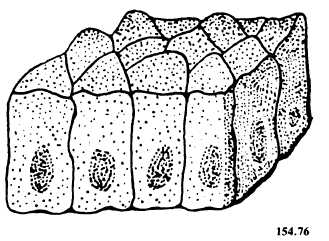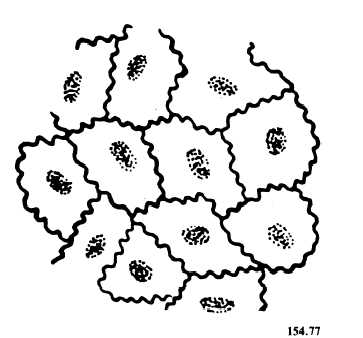materials between the cell and its environment by physical and chemical means. Solids and gases, such as oxygen, proteins, carbohydrates, and mineral salts, pass through the plasma membrane by a process known as DIFFUSION.
The NUCLEUS is a small, dense, usually spherical body that controls the chemical reactions occurring in the cell. The substance contained in the nucleus is called NUCLEOPLASM. It is also important in the cell’s reproduction, since genetic information for the cell is stored there. Every human cell contains 46 chromosomes, and each chromosome has thousands of genes that deter- mine the cell’s function.
The CYTOPLASM is a water-to-gelatinous substance surrounding the nucleus and is con- tained by the plasma membrane. The cytoplasm is all of the cell protoplasm except the nucleus.
The simplest living organism consists of a single cell. The amoeba is a unicellular animal. The single cell of such a one-celled organism must be able to carry on all processes necessary for life. This cell is called a SIMPLE or UNDIFFEREN- TIATED CELL.
In multicellular organisms, cells vary in size, shape, and number of nuclei. When stained, the various cell structures can be more readily recognized under a microscope. Other differences such as the number and type of cells can be seen with the aid of a microscope. Many cells are highly specialized. SPECIALIZED CELLS perform special functions, such as muscle, which contracts, or epithelial cells of the skin, which protect.
TISSUES
Tissues are groups of specialized cells similar in structure and function. They are classified into five main groups: epithelial, connective, muscular, liquid, and nervous.
1. EPITHELIAL. The lining tissue of the body is called epitheliums. It forms the outer covering of the body known as the free surface of the skin. It also forms the lining of the digestive, respiratory, and urinary tracts; blood and lymph vessels; serous cavities; and tubules of certain secretory glands, such as the liver and kidneys. This tissue has little intercellular fluid and may be further subdivided into three types:
a. Columnar. The chief functions of this tissue are to secrete digestive fluids and absorb digested foods and fluids. It consists of long narrow cells set close together, resembling a palisade-type fence (fig. 3-3). In certain areas, such as the nostrils, bronchial tubes, and tra- chea, this tissue has a crown of micro- scopic hairlike processes known as cilia. These cilia provide motion to move secretions and other matter along the surfaces from which they extend. They also act as a barrier, preventing foreign matter from entering these cavities.

Figure 3-3.—Columnar epithelial tissue
b. Squamous. This is the main protective tissue of the body. It is composed of thin platelike or scalelike cells forming a mosaic pattern (fig. 3-4). This tissue

Figure 3-4.—Squamous epithelial tissue.
